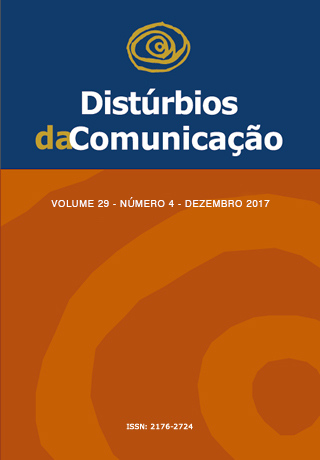El vendaje elástico como recurso terapéutico para la gestión de babeo: análisis de su eficacia
DOI:
https://doi.org/10.23925/2176-2724.2017v29i4p663-672Palabras clave:
Fonoaudiología, Sialorrea, Ensayo clínicoResumen
Objetivo: Verificar la eficacia de la aplicación del vendaje elástico en la musculatura suprahioidea en pacientes con parálisis cerebral. Método: Estudio clínico prospectivo con análisis de la técnica de aplicaciones estandarizadas de vendaje elástico en la musculatura suprahioidea, realizada por 8 semanas, consistiendo en cambio tres veces por semana. Para analizar la eficacia del procedimiento, cuestionarios fueron aplicados (calidad de vida, control de deglución de la saliva, de frecuencia y gravedad de la sialorrea) y se realizó evaluación de la estadificación de la sialorrea en períodos pre y pos-terapias. Se compararon dos grupos de pacientes, uno denominado por espera asistida y otro experimental, ambos con cuatro sujetos en el grupo, divididos igualitariamente entre los sexos, con edades entre cuatro y doce años (9 años ± 3,55) para el grupo experimental y entre tres y siete años (4,25 ± 1,89) el de espera asistida. El vendaje elástico se considera eficaz cuando el total de puntos obtenidos tras el procedimiento fue igual o superior a tres puntos. Resultados: Hubo disminución de la sialorrea en todos los sujetos del grupo experimental por medio de la aplicación del vendaje elástico y mejora en la calidad de vida. No obstante, en el grupo de espera asistida no se observó progreso. Conclusion: La eficacia de la aplicación del vendaje elástico para el control de la sialorrea fue comprobada en el grupo experimental, contribuyendo para el conocimiento en el área de la motricidad orofacial, además de enfatizar la reflexión acerca de procedimientos fonoterapéuticos no invasivos.Descargas
Descargas
Publicado
Número
Sección
Licencia
Derechos de autor 2017 Claudia Sordi, Brenda Lima Araújo, Lavínia Vieira Dias Cardoso, Laura Alves Verena Correia, Géssica Matos de Oliveira, Sinthia Stefanny Souza da Silva, Carla Patrícia Hernandez Alves Ribeiro César

Esta obra está bajo una licencia internacional Creative Commons Atribución 4.0.









